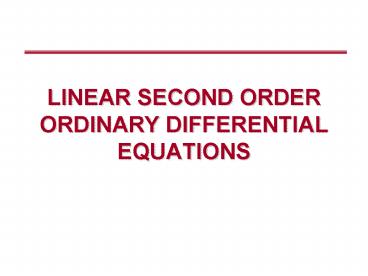LINEAR SECOND ORDER ORDINARY DIFFERENTIAL EQUATIONS - PowerPoint PPT Presentation
1 / 14
Title:
LINEAR SECOND ORDER ORDINARY DIFFERENTIAL EQUATIONS
Description:
Bessel's equation. Hypergeometric equation. When function g(x) is set to zero: ... Suppose p and q in eqn above are continuous on a x b then for any twice ... – PowerPoint PPT presentation
Number of Views:1250
Avg rating:5.0/5.0
Title: LINEAR SECOND ORDER ORDINARY DIFFERENTIAL EQUATIONS
1
LINEAR SECOND ORDER ORDINARY DIFFERENTIAL
EQUATIONS
2
- The general form of the equation
- where P, Q, R, and G are given functions
- Samples of 2nd order ODE
- Legendres equation
- Bessels equation
- Hypergeometric equation
3
- When function g(x) is set to zero
- This is the homogeneous form of 2nd order ODE
- Suppose p and q in eqn above are continuous on
altxltb then for any twice differentiable function
f on altxltb, the linear differential operator L is
defined as - Lf f pf qf
- Ly y p(x)y q(x)y 0
4
Solutions of Homogeneous Equation
- Theorem
- If y y1(x) and y y2(x) are solutions of the
differential equation - Ly y p(x)y q(x)y 0
- then the linear combination of y c1y1 (x)
c2y2 (x), with c1 and c2 being arbitrary
constants is also a solution.
5
Application of 2nd Order ODE
- Two concentric cylindrical metallic shells are
separated by a solid material. If the two metal
surfaces are maintained at different constant
temperatures, what is the steady state
temperature distribution within the separating
material?
6
(No Transcript)
7
Solution
8
Sample of Transport Model (1)
- Consider the axial flow of an incompressible
fluid in a circular tube of radius R. By
considering long tube and assuming q-component
and r-component of velocities are negligible, one
can reduce the z-component for constant r and m - Equation of continuity reduces to
9
Sample of Transport Model (2)
- Derive the temperature profile T, in a solid
cylinder with heat generation if the governing
differential equation is - where the coordinate system indicates the
independent variables r is the mass density and
Cp the specific heat.
10
Example 1
- Consider a long solid tube, insulated at the
outer radius ro and cooled at the inner radius ri
with uniform heat generation q within the solid. - Determine the general solution for the
temperature profile in the tube - Suppose the maximum permissible temperature at
the insulated surface ro is To. Identify
appropriate boundary conditions that could be
used to determine the arbitrary constants
appearing in the general solution and find the
temperature distribution. - What is the heat of removal rate per unit length
of tube? - If the coolant is available at a temperature T,
obtain an expression for the convection
coefficient that would have to be maintained at
the inner surface to allow for operation at the
prescribed values of To and q.
11
- Assumptions
- Steady state conditions
- One dimensional radial conduction
- Physical properties are constant
- Volumetric heat generation is constant
- Outer surface is adiabatic
ri
12
Example 2
- A tubular reactor of length L and
cross-sectional area 1.0 m2 is used to carry out
a first order chemical reaction of the type - A ? B
- The rate coefficient is k (sec-1). In a given
feed rate of u m3/sec, the initial feed
concentration of species A is Co and the
diffusivity of A is D m2/sec. What is the
concentration of A as a function of the reactor
length? It may be assumed that during the
reaction the volume remains constant and that
steady-state conditions are established. Also
there is no concentration variation in the
section following the reactor.
13
Example 3
- Two thin wall metal pieces of 1 outside diameter
are connected by ½ thick and 4 diameter flanges
that are carrying steam at 250oF. Determine the
rate of heat loss from the pipe and the
proportion that leaves the rim of the flange. - Thermal conductivity of the flange metal is
k220 Btu/h ft2oF ft-1 - The exposed surfaces of the flanges lose heat to
the surroundings at T1 60oF according to heat
transfer coefficient h 2 Btu/h ft2oF
14
Pipe Flange
r
½ in
2 in

